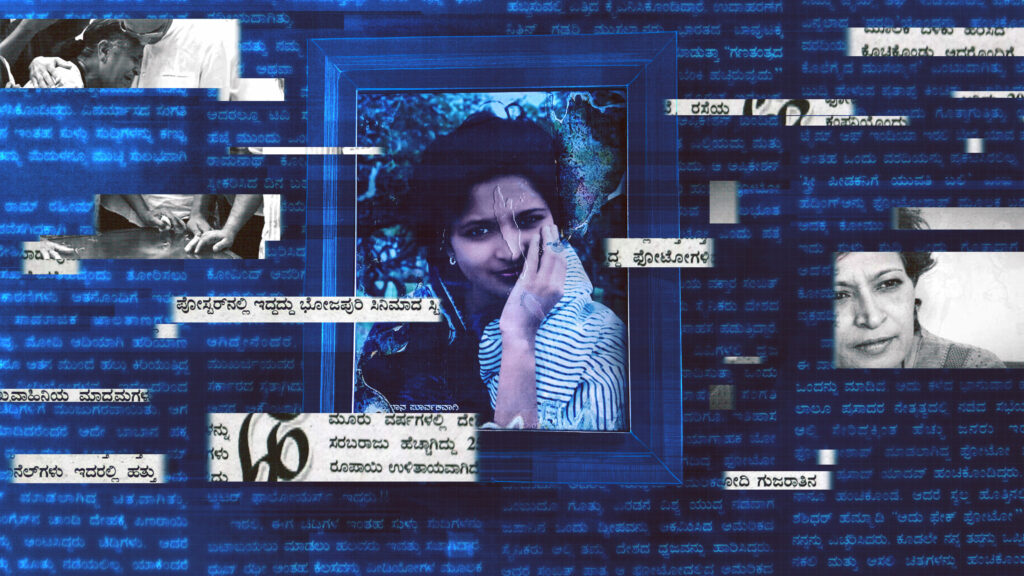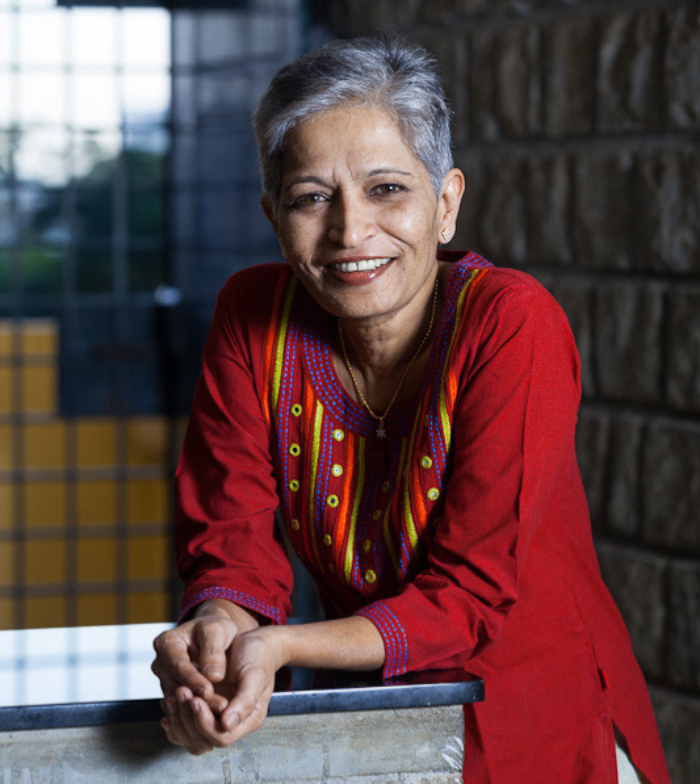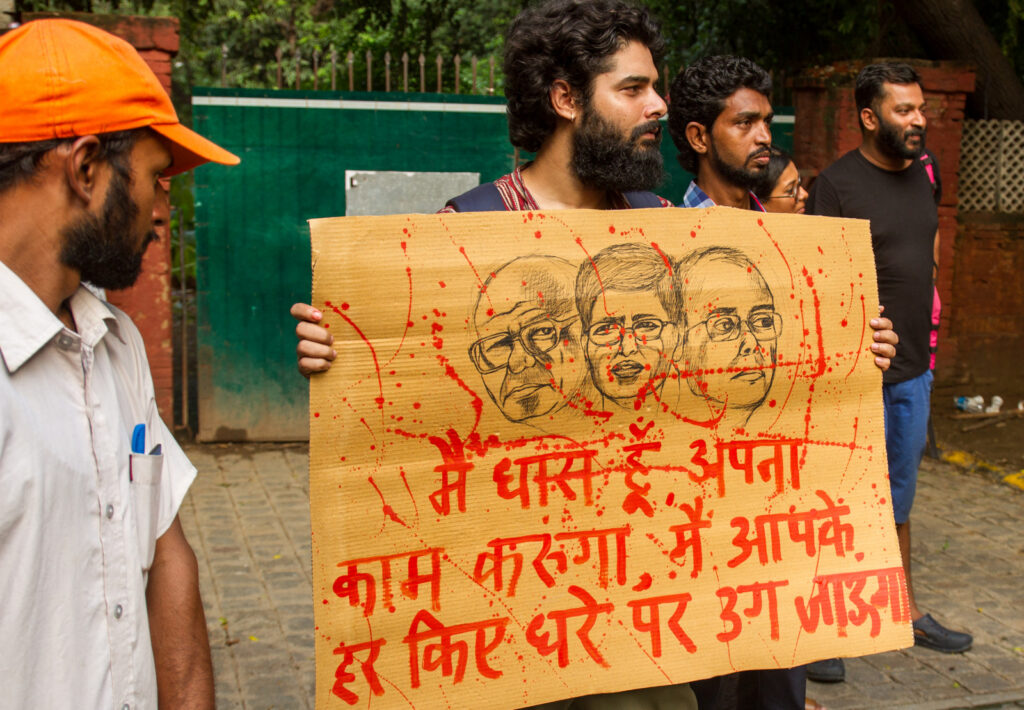Story Killers (Part 1): In the Age of False News–A Journalist, a Murder, and the Pursuit of an Unfinished Investigation in India
MEDIA, 20 Feb 2023
Phineas Rueckert | Forbidden Stories/Story Killers – TRANSCEND Media Service
In 2017, journalist Gauri Lankesh was assassinated in Bangalore days before she planned to publish an article about disinformation. Over five years later, Forbidden Stories pursued Lankesh’s work on fake news and explored new leads in her murder case.
14 Feb 2023 – On September 5, 2017, 55-year-old journalist Gauri Lankesh arrived late at her office in Bangalore. It was a warm day with a light wind in this southern Indian city known for its breezy weather and traffic. At her office, the ground floor of a faded yellow, three-story building on a residential street, she reviewed the upcoming issue of her weekly magazine and put the finishing touches on her editorial, which she always wrote last.
Concerns about the rise of disinformation in India and her experience as a high-profile target of digital hate campaigns weighed on Lankesh as she wrote the piece, which she titled, “In the Age of False News.” Lankesh elucidated how “lie-factories” – websites that traffic in rumors and half-truths – spread disinformation in India. She detailed a viral rumor about censorship of a Hindu idol by the opposition party, tracing it to one of the most virulent of these sites called Postcard News, run by a local entrepreneur named Mahesh Vikram Hegde. The rumor, she elaborated, was further spread by the ruling Bharatiya Janata Party (BJP) and other politically-motivated individuals who “used the fake news as their weapon,” she wrote.
She had been finessing the article for several days, and it was meant to come out two days later. Setting the piece aside, she was in an uncharacteristically cheerful mood, friends and family remember, and spent the afternoon chatting with feminist activists.
Dusk had settled over Bangalore as Lankesh headed home, weaving through the streets of India’s bustling tech capital. Had it been another night, she might have dropped by her sister’s house to binge-watch the show “This Is Us,” as she had done on prior evenings. Instead, she went straight to her home, in a hamlet of calm where loud noises are uncharacteristic. As Lankesh walked up to the entryway of her house, the cracks of four gunshots echoed through the neighborhood. The first shot hit Lankesh below her right shoulder on her back. Two bullets lodged in her abdomen, piercing her vital organs, while a fourth ricocheted off the wall of her house. A motorcyclist and his accomplice fled the scene, shielding their faces from CCTV cameras.
Lankesh – who died instantly – never saw her editorial in print.
Lankesh’s murder soon sent shockwaves across India. Hundreds of mourners attended her funeral, holding signs reading, “I am also Gauri.” Within a couple of years, police investigators arrested 17 suspects, all associated with the Hindu nationalist cult Sanatan Sanstha, its affiliate Hindu Janajagruti Samiti (HJS) and other fringe religious groups. (An 18th suspect is still at-large.) Members of this unnamed syndicate plotted the assassination for over a year, obtaining weapons, training hired guns and tracking Lankesh’s daily movements, according to police sources. (A trial is currently ongoing in Bangalore. In an email, a Sanatan Sanstha representative wrote: “Your questions pertain to a case that is subjudice. It would be inappropriate to comment on such matters as the Indian judiciary is an independent body.”)
Forbidden Stories, whose mission is to continue the work of threatened, imprisoned or assassinated journalists, pursued Lankesh’s unfinished work. Starting from Lankesh’s premise – that disinformation has become both industrial and weaponized – Forbidden Stories gathered a consortium of 100 journalists from 30 media outlets to investigate the global disinformation-for-hire market as part of the “Story Killers” project. From India to South America to the heart of Europe, journalists peeled back the layers of a growing and unregulated market, ranging from small-time fake news peddlers to multinational mercenaries selling disinformation campaigns aimed at subverting democracies.
Now just over five years after Lankesh’s murder, Forbidden Stories accessed case files, spoke with local police and lawyers, and investigated an unexplored lead in the criminal investigation: how a viral 2012 YouTube video of Lankesh spread across social media and was later shown to the people who allegedly killed her as “justification” for her murder.
An inconvenient journalist
Lankesh is now a towering figure in Bangalore, where she grew up and later returned in her late 30s. At Koshy’s, an old-fashioned dining hall where Lankesh was a regular, restaurant owner Prem Koshy still thinks of the seat near the window as hers. Reporters look back fondly on interactions with Lankesh, who some say inspired them to join the field.
But before her death, Lankesh was not a household name, unlike her father. Author of the eponymous Lankesh Patrike – or “Lankesh’s Paper” in Kannada, the local language – P Lankesh was famous for his investigations on corruption and politics during a time many consider the golden era of Indian journalism – a period of unprecedented editorial independence starting in the early 1980s.
“My father had brought down governments with his exposes on corruption,” Kavitha Lankesh, Lankesh’s younger sister, told Forbidden Stories in her Bangalore office, located upstairs from where Lankesh had once worked.
Lankesh, she explained, had not started journalism with such ambitions.
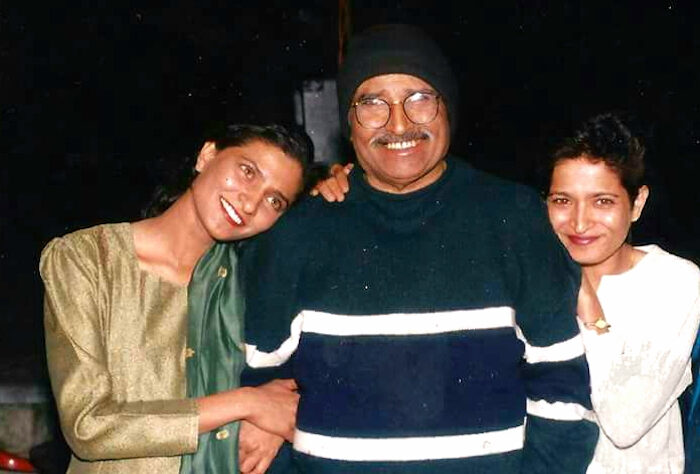
Gauri Lankesh (right) poses for a picture alongside her sister Kavitha and father, P Lankesh. Photo courtesy of Kavitha Lankesh.
Lankesh began her career in Delhi, writing everything from criminal investigations to profiles for Times of India, ETV Telugu and Sunday Magazine. It wasn’t until 2000, when she returned to Bangalore to take over Lankesh Patrike after her father died, that Lankesh’s writing took a political turn and her tongue a sharper edge. The move, colleagues and family recall, led to a “transformation” in how Lankesh understood her role as a journalist.
In 2005, Lankesh created a weekly, naming it Gauri Lankesh Patrike. In editorials and reportage from remote regions of Karnataka, her home state, the Patrike took on the establishment and railed against the rise of far-right Hindu nationalists. The paper investigated illegal mining in north Karnataka, local corruption and religious polarization. One of its main targets, however, was the Hindu nationalist Bharatiya Janata Party – or BJP. (Twice, Lankesh was accused of defamation by Pralhad Joshi, a BJP member of parliament.)
Lankesh, who described herself as a journalist-activist, saw combating fake news spread by the BJP as part of a larger battle against the Indian far-right, colleagues said. “The magazine that she was editing for more than a decade was working against [communal disharmony],” Dr HV Vasu, a colleague, told Forbidden Stories, referring to inter-religious conflict in India. “So fighting fake news was very much integral to that.”
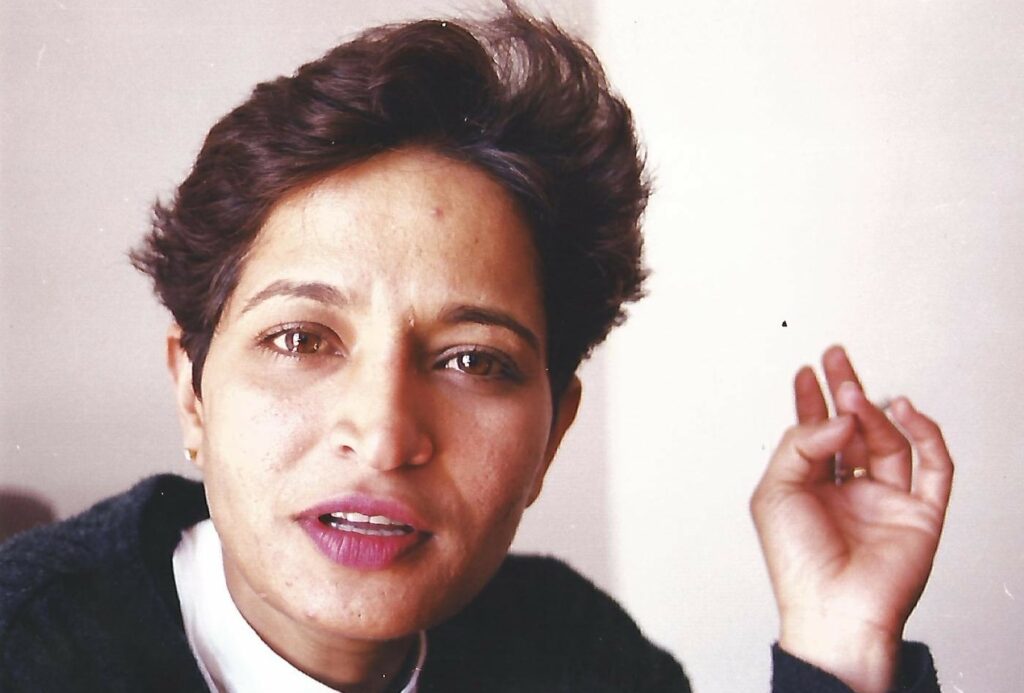
Journalist Gauri Lankesh during a year abroad in Paris. Photo courtesy of Kavitha Lankesh.
Even in her early years running the Patrike, Lankesh’s writing underscored the harm of politicians manipulating information. “He believes in the power of a lie acquiring the garb of truth with constant repetition,” she wrote of former BJP Prime Minister Atal Bihari Vajpayee. In another article debunking a viral rumor, she referred to “the fake ‘facts’ of history,” alluding to claims that a former ruler from the region had attempted to forcibly convert Hindus to Islam.
Her greater visibility as a journalist and activist contesting Hindu nationalism may have troubled powerful interests in Karnataka, considered by some to be a laboratory for seeding narratives that create religious strife.
Speaking from his office off Bangalore’s main drag, advocate BT Venkatesh chuckled, thinking about the countless times he represented Lankesh in court. “She would fire in every angle,” Venkatesh recalled. “A gangster would file a case against her. A politician would file a case against her. Some businessmen would file a case against her. She would target anyone who was corrupt.”
Even as legal threats mounted, she continued to publish scathing takedowns of the ruling party, as well as opposition figures and corrupt elites. “What she did was something extraordinary. The grit, the gumption, the kind of way she looked at the magazine. In the span of two years, she transformed it,” Venkatesh said.
As Lankesh evolved, so too did India. In the mid-2010s, the Hindu nationalists Lankesh had been covering went mainstream. The 2014 election of Narendra Modi catapulted the BJP to power thanks, at least partly, to an expansive network of “IT cells” aimed at spreading positive news about the BJP and attacking its detractors, a group to which Lankesh would come to belong.
According to Joyojeet Pal, an associate professor at the University of Michigan who studies disinformation and politicians’ use of social media, IT cells are structured like a pyramid, with party leaders at the top and a network of influencers at the middle and bottom. The bottom layer plays a key role in creating and trending narratives, while also maintaining enough distance from the top to give leaders plausible deniability if the digital foot soldiers become too extreme. These low-level influencers also work to discredit those who “dissent” against the party line, such as independent journalists or activists.
“There is a certain kind of casting of aspersion on their character or motive based on who they are and what they have covered in the past, and the discrediting happens through that association,” he said. This causes a “chilling effect on journalists who then don’t want to engage online” anymore, he said.
In personal emails to her ex-husband, journalist Chidanand Rajghatta, Lankesh admitted to feeling disillusioned by this pyramidal ecosystem. “When Modi mania becomes a popular mantra, when fascist fury becomes part of daily discourse, when distorted news becomes the mantra of mainstream media, when religious fundamentalism blinds people…I get disgruntled, disenchanted, disturbed,” she wrote in August 2016.
Friends said that by the end of her life, Lankesh seemed unwell: her paper was losing subscribers and accruing debt because Lankesh refused to take on advertisers, and she had become the target of near-constant online harassment by far-right networks connected to the BJP. The trolling would peak after Lankesh would give a speech or post personal photos online that far-right activists used to portray her as a “loose” woman. The character assassination intensified toward the end of her life, with negative content cross-posted in popular right-wing Facebook pages.
In late 2016, about a year before she was killed, her name trended negatively on Twitter after she was convicted of libel and released on bail. Social media posts described Lankesh as a “commie,” “naxalite,” and “prestitute,” a term combining “press” and “prostitute” typically used to attack female journalists. In one widely shared post, Postcard News, which Lankesh named in her editorial, described her as a “known Hindu hater.” The article, which linked to a now-removed YouTube video of a speech Lankesh had given in 2012 and was allegedly shown to at least 5 of her presumed assassins, was shared on social media by Postcard co-founders Mahesh Vikram Hegde and Vivek Shetty.
Angry comments often followed the posts. “Hang them,” one Facebook user wrote.
Lankesh did not let on to the magnitude of the trolling she experienced and told friends and colleagues not to take online threats seriously. “[Online trolling] is the last of things you should worry about,” investigative journalist Rana Ayyub remembers Lankesh telling her several days before her assassination. “I didn’t know the extent of how vicious it was,” Lankesh’s sister added.
But in the final months of her life – at the suggestion of a colleague – Lankesh begrudgingly installed a CCTV camera in her house. Friends also pushed her to hire a security detail, but she thought it unnecessary.
Around then, Lankesh and colleagues had discussed launching a fact-checking project, using a decentralized network of WhatsApp groups to counter viral rumors. It wasn’t the first time Lankesh had expressed an interest in fact-checking, but according to her friends and colleagues, the idea of doing it more rigorously and professionally had emerged toward the end of her life. In the days before her death, Lankesh compulsively shared fact-checks on her personal Twitter account, including from Alt News, a fact-checking site run by Mohammed Zubair and Pratik Sinha, who were contenders for a 2022 Nobel Peace Prize for their work on disinformation in India.
Her final editorial, colleagues and family said, was borne from an obsessive quest for truth – but also to admit an error in judgment. Lankesh disclosed that she had accidentally shared a doctored image on Facebook. The photo appeared to show a large rally in favor of the opposition Congress Party but had been photoshopped to inflate the crowd size, fact-checkers later revealed. “There was no intent to incite communal reaction or propaganda,” she wrote. “I only wanted to convey the message that people are coming together against fascist forces.” She concluded with a call to action: “I want to salute all those who expose fake news. I wish there were more of them.”
The many-headed hydra
________________________________
Additional reporting by Srishti Jaswal for Forbidden Stories.
Oishika Neogi (Confluence Media), Prajwal Bhat (The News Minute) and Laura Höflinger (Der Spiegel) contributed interviews and research.
(This article is Part I of the Story Killers project – a global investigation into disinformation mercenaries.)
Tags: Corporate Media, Corruption, Fake News, Fake Report, Forbidden Stories, Integrity, Investigative Journalism, Journalistic Ethics, Mainstream Media MSM, Media, Military Industrial Media Complex, Official Lies and Narratives, War Journalism
DISCLAIMER: The statements, views and opinions expressed in pieces republished here are solely those of the authors and do not necessarily represent those of TMS. In accordance with title 17 U.S.C. section 107, this material is distributed without profit to those who have expressed a prior interest in receiving the included information for research and educational purposes. TMS has no affiliation whatsoever with the originator of this article nor is TMS endorsed or sponsored by the originator. “GO TO ORIGINAL” links are provided as a convenience to our readers and allow for verification of authenticity. However, as originating pages are often updated by their originating host sites, the versions posted may not match the versions our readers view when clicking the “GO TO ORIGINAL” links. This site contains copyrighted material the use of which has not always been specifically authorized by the copyright owner. We are making such material available in our efforts to advance understanding of environmental, political, human rights, economic, democracy, scientific, and social justice issues, etc. We believe this constitutes a ‘fair use’ of any such copyrighted material as provided for in section 107 of the US Copyright Law. In accordance with Title 17 U.S.C. Section 107, the material on this site is distributed without profit to those who have expressed a prior interest in receiving the included information for research and educational purposes. For more information go to: http://www.law.cornell.edu/uscode/17/107.shtml. If you wish to use copyrighted material from this site for purposes of your own that go beyond ‘fair use’, you must obtain permission from the copyright owner.
